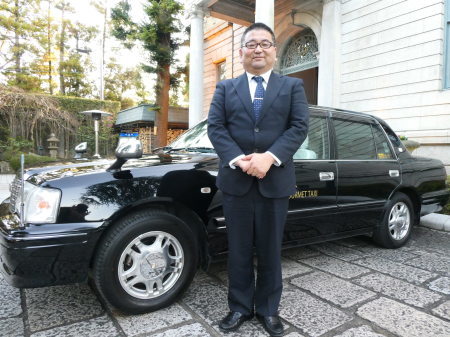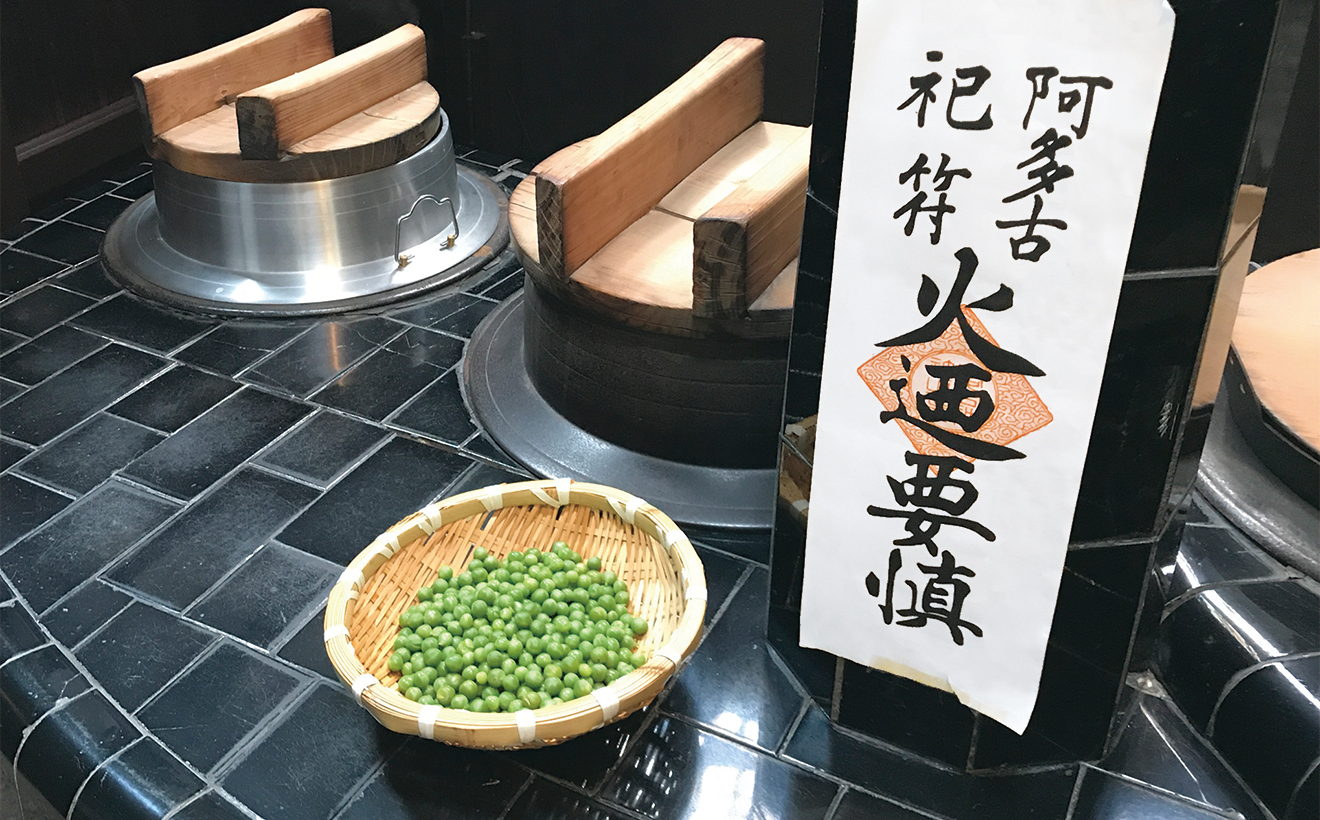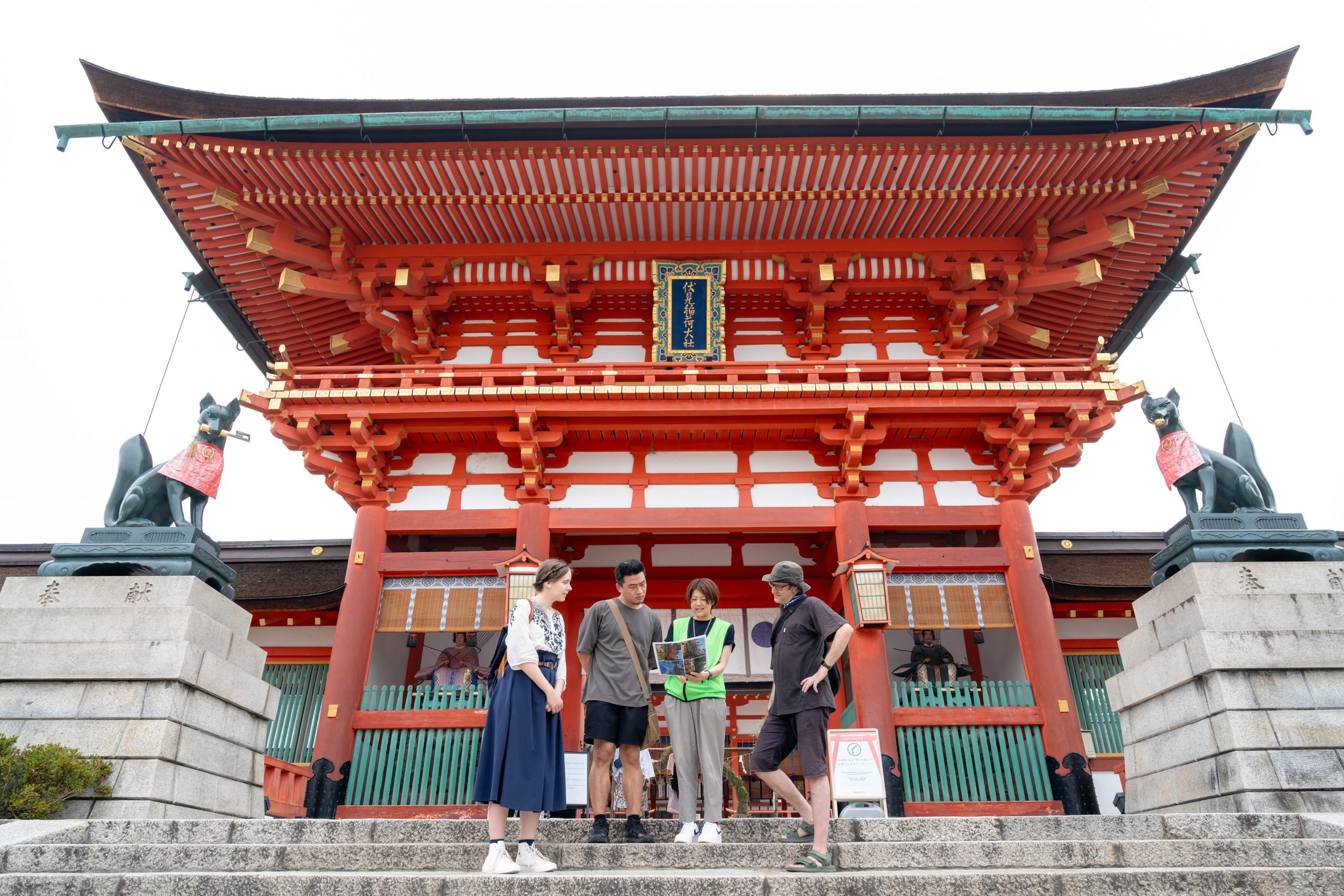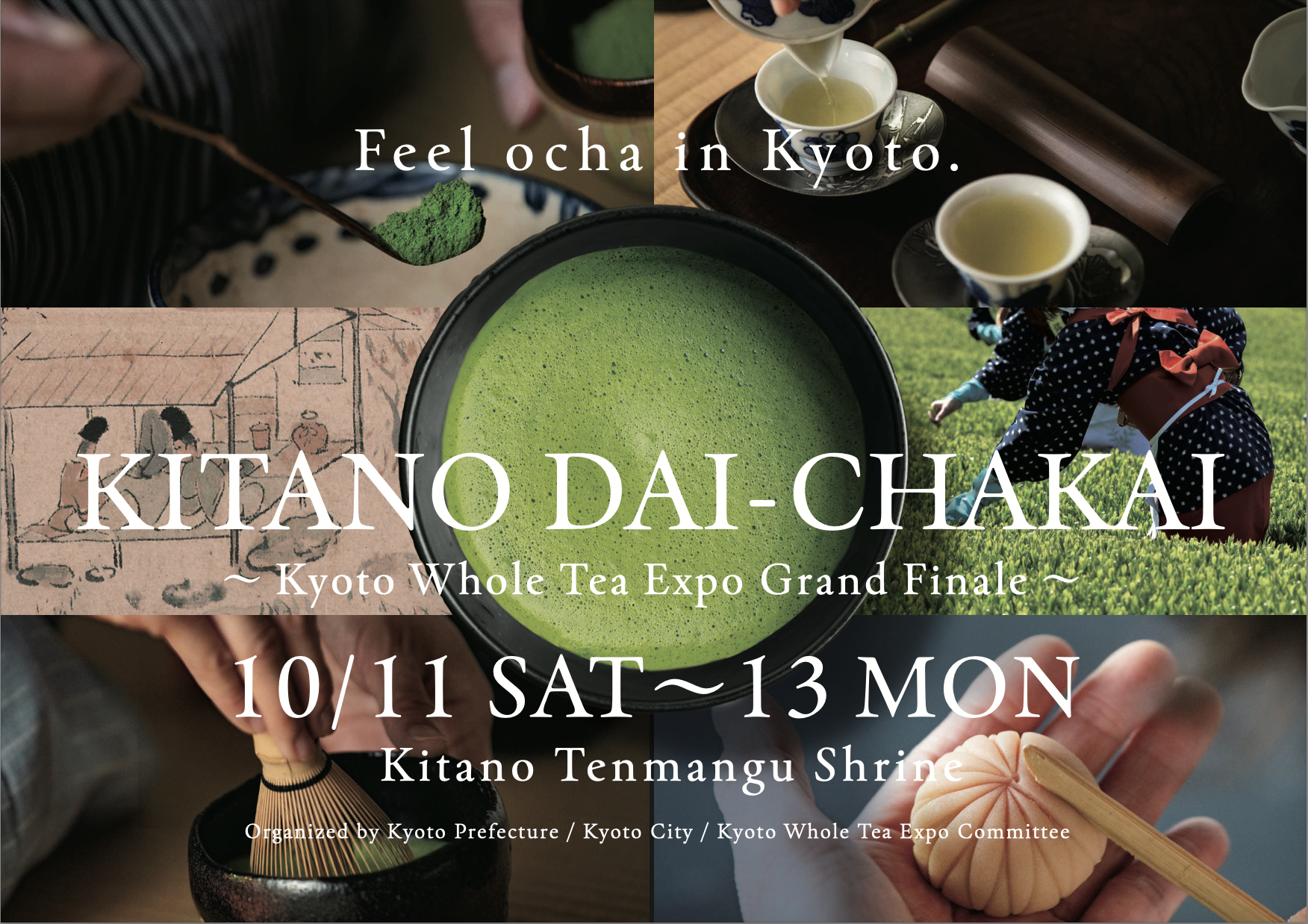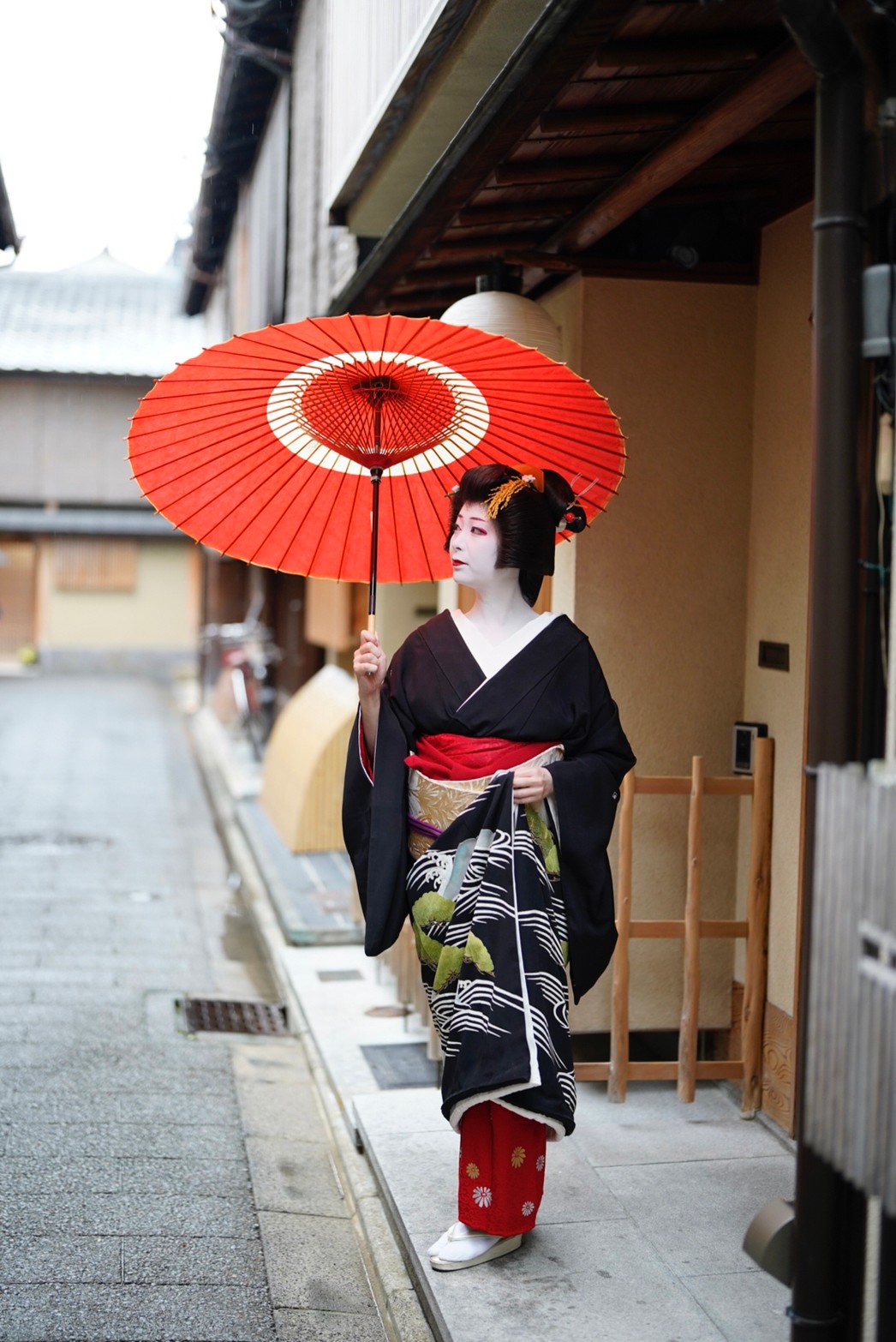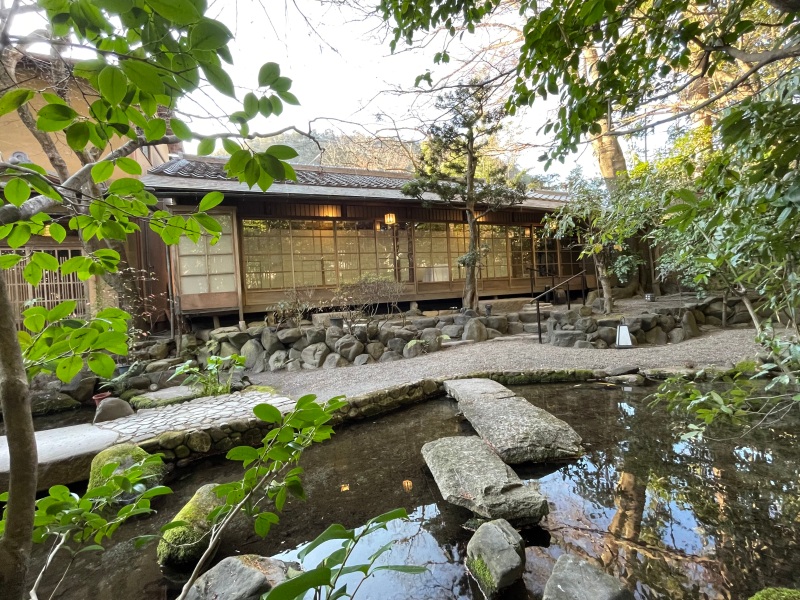
Kyoto is famous and beloved throughout the world for its unique historical beauty and culture. Where Kyoto is different to other ancient cities is what it is made from: while Greece’s Acropolis is made of limestone and marble, and Cambodia’s Angkor Wat temple complex is crafted from sandstone, old Kyoto is mostly made of the more fragile material of wood. It expresses the transience that is central to the Japanese view of life and gives Kyoto a unique, refined gentleness, but it also poses the question of just how long the historic beauty of Kyoto can remain. To encourage foreign visitors to Kyoto to help fund its preservation, Kyoto City has created the Preserve Kyoto Gift digital coupon.
The landscape of Kyoto
For more than a thousand years Kyoto was the capital of Japan. Its role in the formation of the Japanese culture and aesthetic during that time (794–1868) was fundamental. Many of the cultural aspects that we think of today as being Japanese were born then, including the tea ceremony and cherry-blossom viewing.
The emperor’s palace was placed in the center of a land basin blessed with rivers and richly forested mountains on three sides. The city’s proximity to nature is key to its charm and Kyoto has carefully preserved the riverfronts and forests that give residents and visitors alike a place to relax and revive.
The hundreds of shrines and temples throughout the city are also rich in nature, with many finely crafted gardens even incorporating the surrounding hills into the gorgeous scenery they create. The aesthetic of Kyoto is very much a world view.
The surrounding mountains have limited the expansion of the central city area, keeping Kyoto to a human scale and forging a walkable city where visitors immediately feel comfortable.
Some of the most familiar views of Kyoto are of tiered pagoda towers, long tunnels of vermillion shrine gates, and historical neighborhoods with flagstone paths and rows of traditional houses in Kyoto’s manner of quiet elegance. Here we can immerse ourselves in the ambience of ancient Japan.
The end of Kyoto’s reign as the nation’s capital may have been its saving. That Tokyo—or Edo—was the capital when Japan started to modernize gave Kyoto the space to develop on its own terms. It established new industries and endeavors, but also held on to what it was proud of. Today, that gives us a Kyoto that embodies what we see when we close our eyes and dream of Japan.
Preserving Kyoto’s old structures by dining at Heihachi Jaya
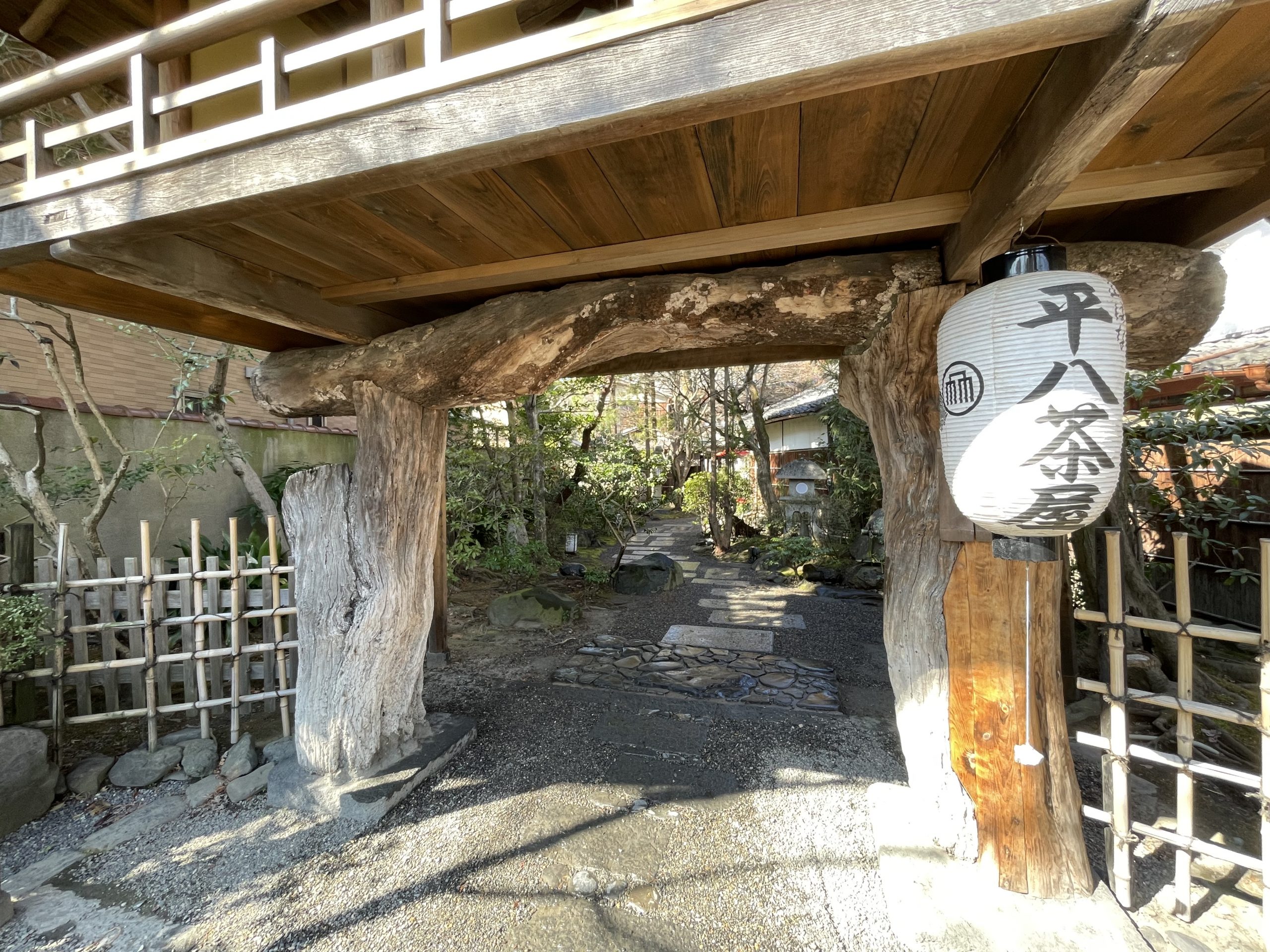
Kyoto today is a patchwork of the old and new. Part of the wonder of exploring Kyoto is suddenly coming across an old wooden house in the traditional style—or a row of machiya townhouses—with their understated tone, latticed windows and old-style, waved tiles. It makes you sigh.
And so it does to suddenly come upon the entrance to Heihachi Jaya, which is one of the restaurants participating in the Preserve Kyoto Gift campaign. More than 440 years old, it is an example of a restaurant that, by changing with the times in order to maintain its popularity, it is preserving beautiful old structures that characterize Kyoto scenery.
Its unique main gate was transported here from a Zen temple centuries ago to mark this place on a historical road trod by people going into and out of the capital. The route’s connection to the Sea of Japan in the north and the transportation of fish into the city gave the road the name “mackerel highway.” Heihachi was the first rest stop out of the city. It started by serving tea as a pick-me-up for travelers. Before long it was also offering a kind of fast food of the day—grated yam on a bowl of rice with barley. It is still on the menu today.
Heihachi’s current menu reflects its development along with the times. When railway and car transportation put an end to foot traffic on the mackerel highway, Heihachi changed its focus from tea to meals. With ocean fish now taking a different route into town, Heihachi turned to river fish instead. It was the father of the current head of Heihachi, Mr. Shingo Sonobe, who later changed the menu to kaiseki cuisine.
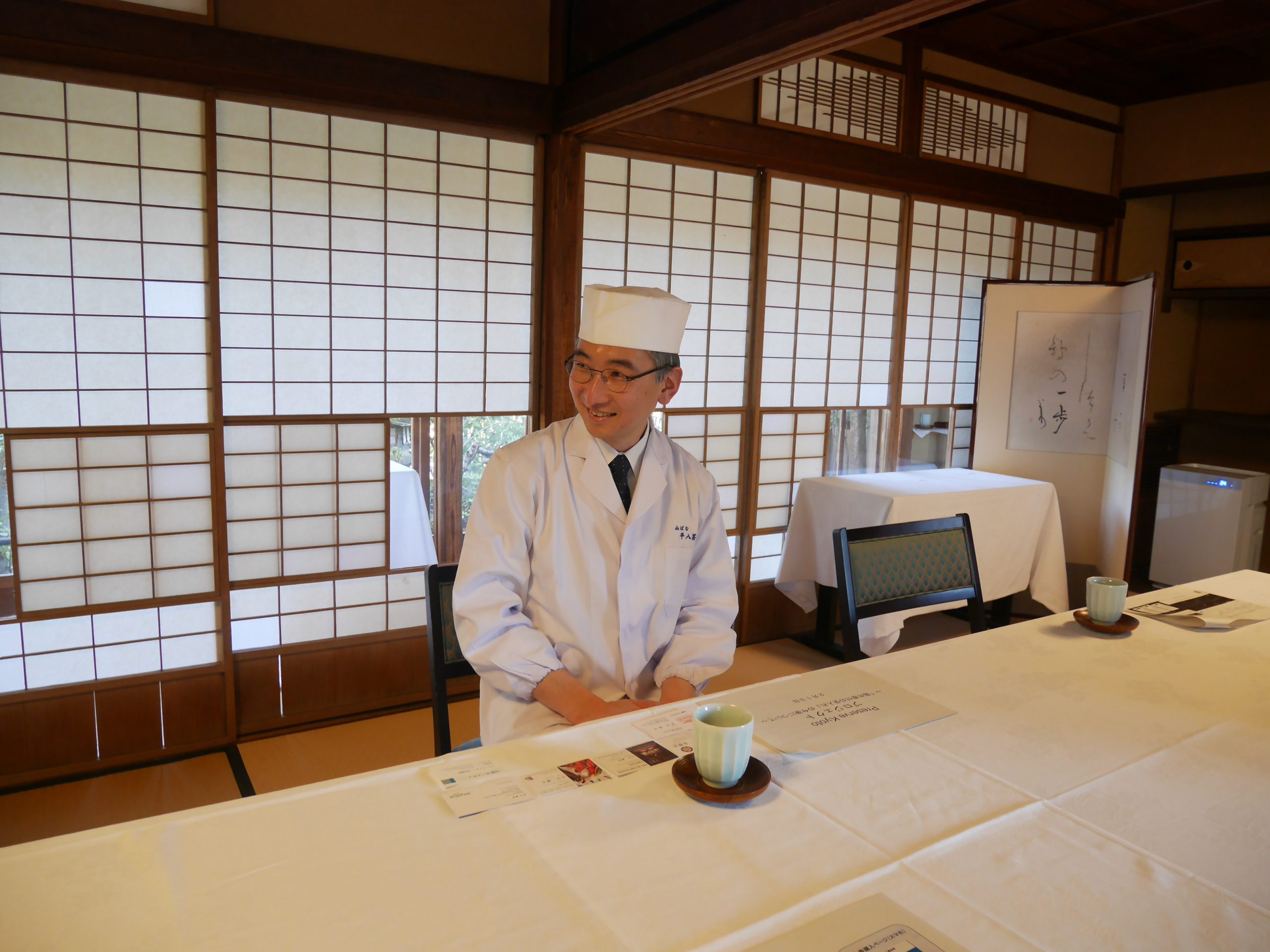
Kaiseki is a traditional, multi-course meal of small, seasonal dishes cooked using a wide range of techniques to create various tastes and textures. It is the most refined form of Japanese cuisine and is also an exploration of Japanese culture. At Heihachi, the kaiseki menu includes river fish and Sea-of-Japan fish, like mackerel and tilefish.
A kaiseki meal takes time, and enjoying it in the traditional surroundings of a restaurant like Heihachi is considered a quintessential way to enjoy one’s time in Kyoto. Here, dining involves all five senses.
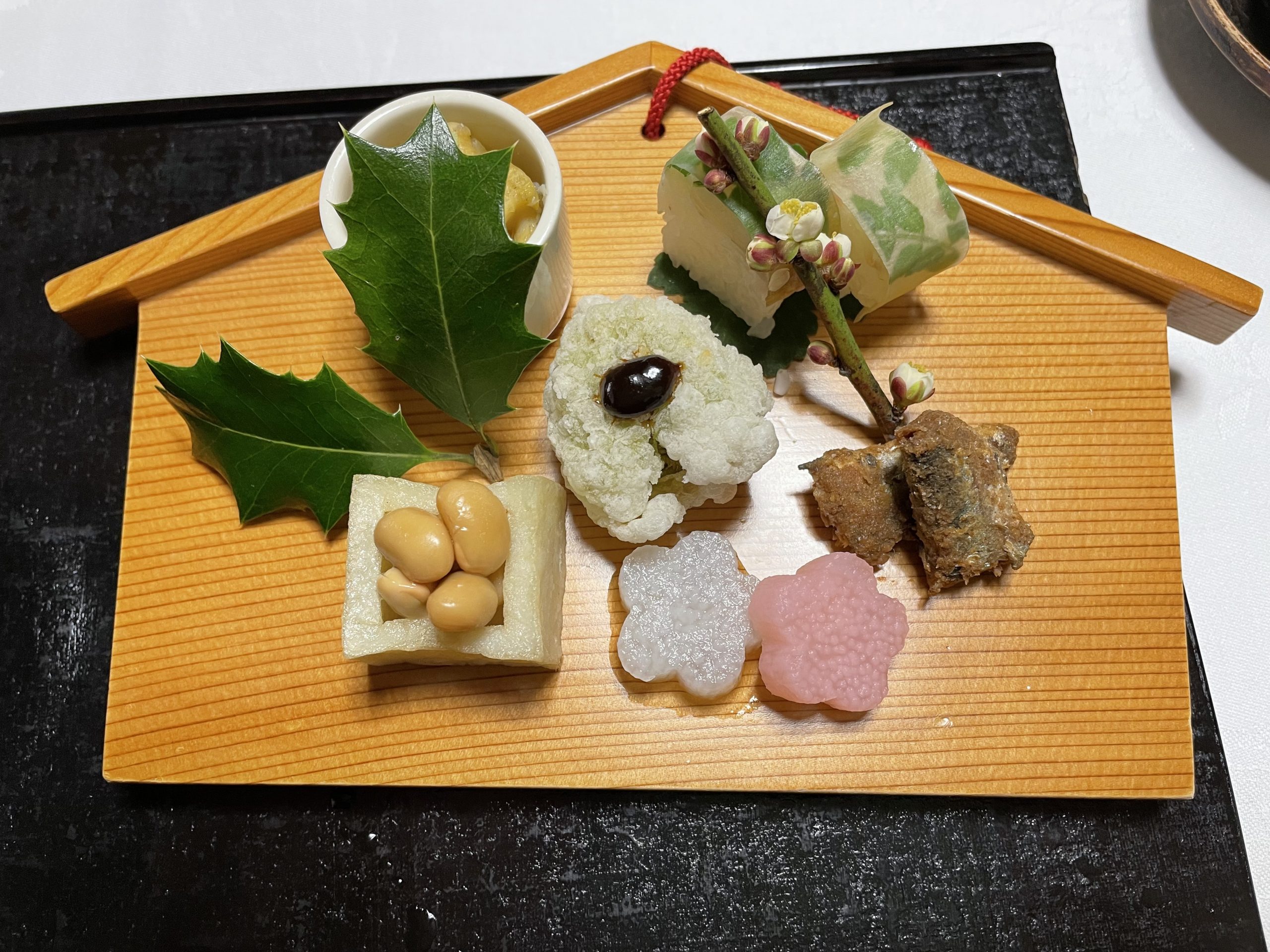
Passing through the entrance gate, you enter a richly green garden alive with water features that culminate in a waterfall. As you step into one of the dining halls, catch the aroma of incense. Enter the dining room and see the straight lines and soft colors of the tatami mat flooring and paper sliding doors. The water you hear is the Takano River, which flows right alongside the restaurant.
Subtly placed mod cons, including an air-conditioner, make Heihachi’s traditional tatami-mat rooms toasty warm on a winter’s day. Another of the room’s Western comforts is more unexpected—chair seating.
Mr. Sonobe recalls his father’s resistance to introducing chairs because they change diners’ eye height and therefore their visual appreciation of the room. But sitting on the floor had become difficult for many customers, so they added chairs to half of the rooms to see how customers would respond. Originally most were content with either, “but gradually an increasing number of our customers would say, ‘thank goodness you have table seating.’ That’s when I changed all the rooms over,” Mr. Sonobe says.
“What’s important is that customers are able to enjoy their meal in comfort,” he explains.
Heihachi’s focus on what its customers want is what has kept it in business for generations, Mr. Sonobe says. “It is because we are constantly changing that we are told ‘this place never changes.’”
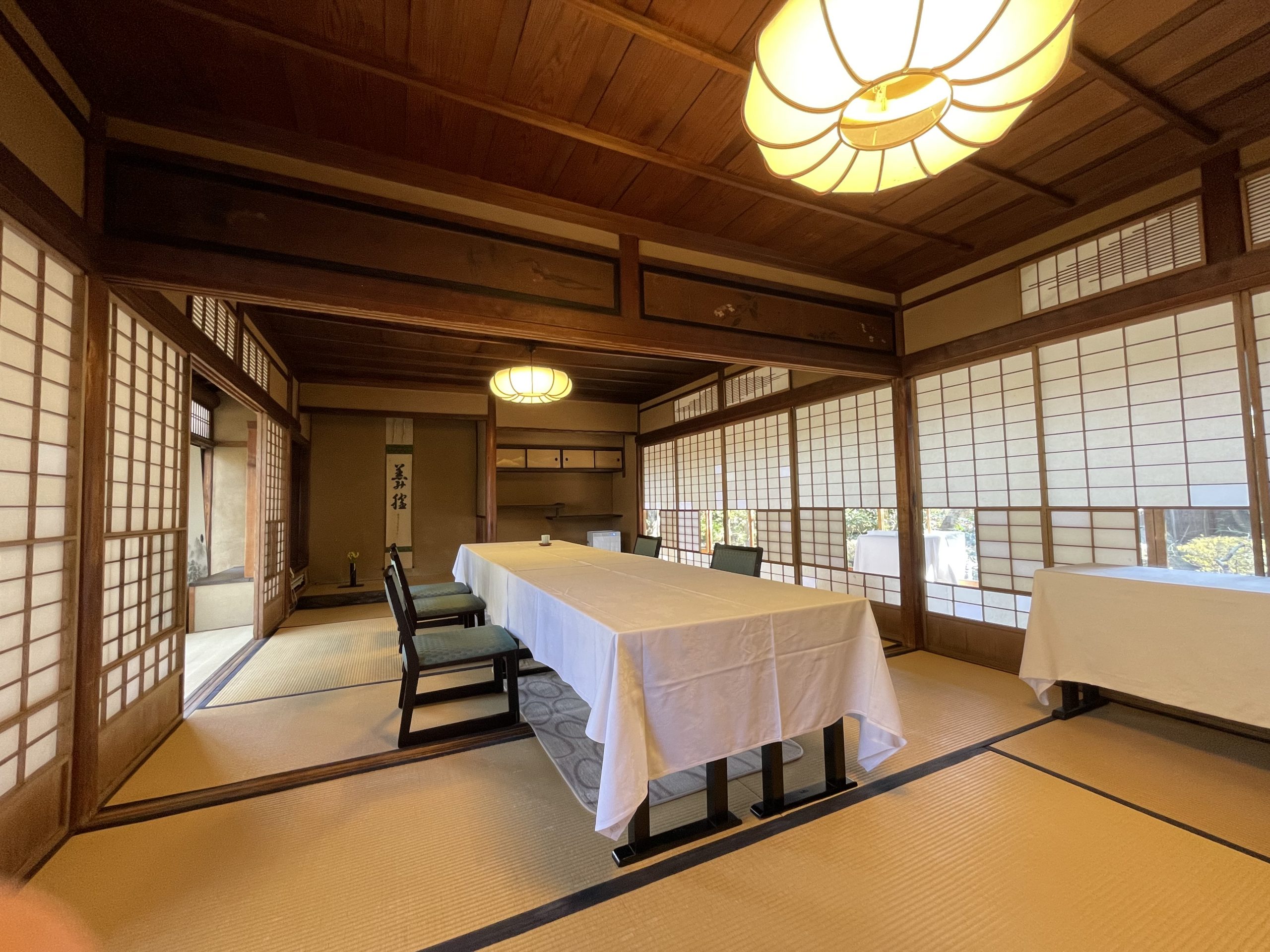
The restaurant regularly reevaluates its operations, including its recipes, changing with the times and with each generation. “We’ve served yam on rice for a very long time, but the current yam on rice is my yam on rice. It’s different to my father’s,” Mr. Sonobe notes.
The continuous coordination by each generation of the restaurant and its cuisine is what keeps it relevant, he says.
Mr. Sonobe is open to change and enjoys trying new things, but he has had to make some tough decisions. Two years ago, rot was discovered in the thatched roof of the magnificent entrance gate. He deliberated over whether to repair it, or pull it down.
It is, of course, ideal to replace damaged sections of structures with the same material, Mr. Sonobe says, but a lack of skilled craftspeople—due to a dearth of similar roofing these days—meant that would be very expensive. A subsidy from Kyoto City helped finance its repair.
“In maintaining old things, funding is the most important factor,” Mr. Sonobe says.

The next factor is the effect his decision will have one or two generations down the line. “I am always thinking from the perspective of how something will be for my children or grandchildren,” Mr. Sonobe explains. “If you make something well, in 30 or 50 years’ time it will have changed into something with its own unique charm. I want to leave behind not something that is old, but something that has elegance.”
In the end, Mr. Sonobe changed the cedar thatching of the main gate to copper sheeting, to maintain the roof’s shape and keep it in good condition for the next 100 years. The base of the gate, which was not damaged, was kept as is.
“What can be achieved in just one generation is extremely limited,” Mr. Sonobe says. Just like the city of Kyoto, he passes on to the next generation the DNA of innovation and tradition, because one does not survive without the other.
Kyoto’s efforts to maintain its unique cityscape
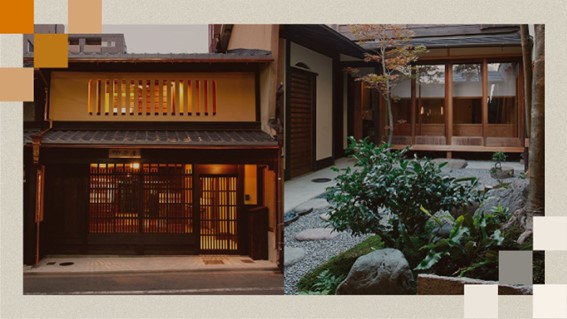
Since as far back as 1930 the Kyoto City government has taken measures to protect the city’s traditional landscape by designating a number of scenic areas, and in 2007 it refined its limits on building heights to keep the city on a human scale that is in line with the centuries-old homes that still remain. These efforts to balance the demands of the commercial world also include requiring outdoor advertising to match the surrounding natural environment and historic townscapes.
The city has prioritized the maintenance of historic landscapes in areas near shrines and temples. As well as setting standards for building designs, it also conserves mountains, forests and bamboo groves, maintains streets in historic areas, and supports cooperation between citizens and businesses to conserve local landscapes.
It has placed a particular focus on halting the gradual disappearance of Kyoto-style traditional machiya townhouses. They are valued for their attractive appearance, and also for the lifestyle and cultural wisdom that their architecture imparts, such as the lighting and summer cooling function of their small, inner courtyard gardens. There are about 40,000 machiya in Kyoto, but around 800 are lost each year. The subsidy system Kyoto City provides for their renovation is helping to maintain them for future generations, but the risk of losing them forever is very real. Because Kyoto is a treasure of the world, the city is giving people from all over the globe the opportunity to help protect and maintain the city’s traditional cityscape.
The Preserve Kyoto Gift dining voucher
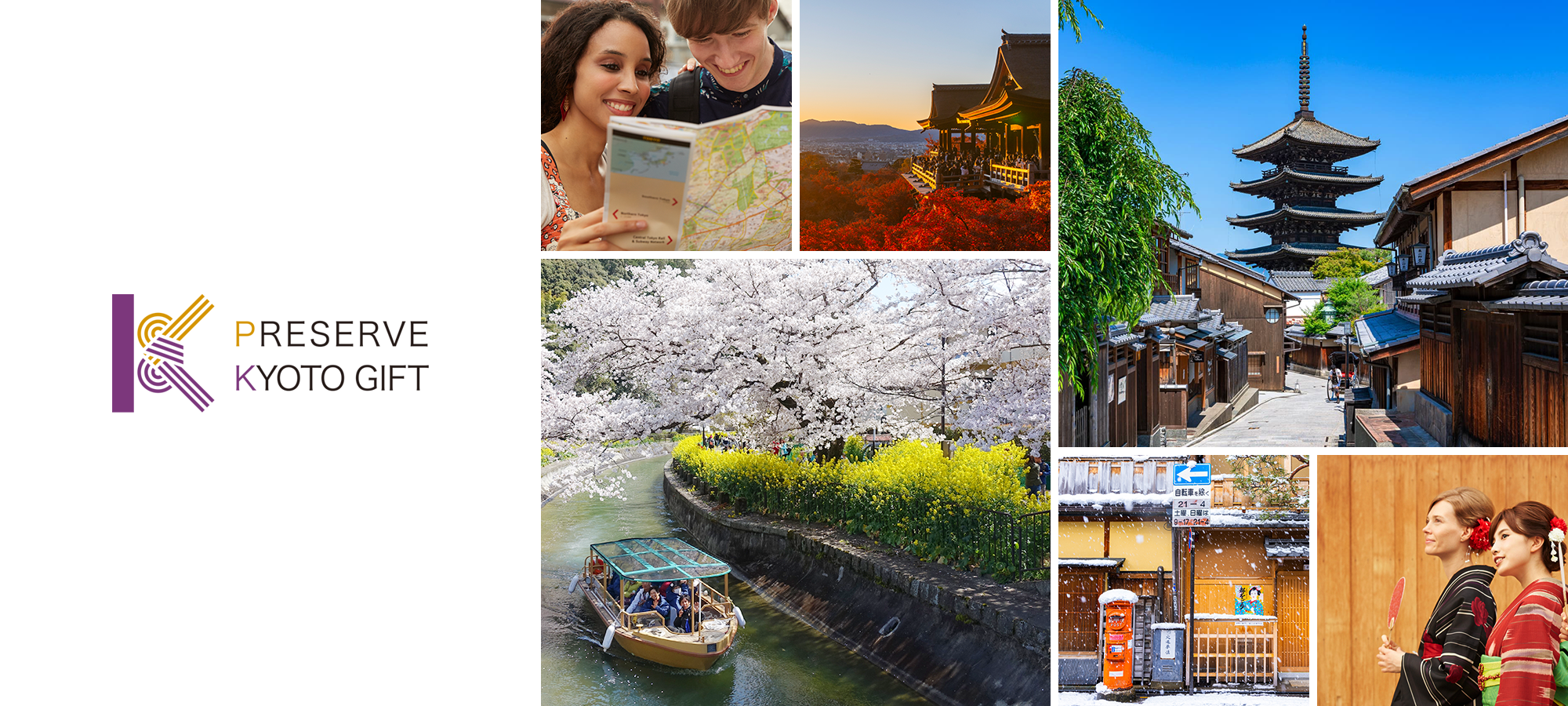
To encourage Kyoto lovers outside Japan to donate to help the city protect, nurture and carefully hand down its nature, landscape and culture to future generations, the city has come up with the Preserve Kyoto Gift coupon. In return for a donation, the person making the donation receives a coupon for a yen-denominated sum that can be used toward payment at establishments involved in the program. It’s a modern-day version of the Japanese tradition of giving something in return after receiving a gift.
It’s easy to use. All you need is a smartphone.

On the project’s website, select the amount you would like to donate and fill in the required information. After you make the payment, you will receive a digital coupon for funds that you can spend at participating Kyoto restaurants. To redeem the digital coupon, just show it when you pay your bill.

Various donation amounts are available, but for example, if you donate 10,000 yen, you will receive a coupon code for 5,000 yen to spend. The coupon is both an expression of gratitude and motivation to visit a participating restaurant, like Heihachi, that is actively preserving the cityscape of Kyoto, to see the effect of your donation in action.
The funds raised via the project will be used by Kyoto City to support the preservation of Kyoto’s cityscape and old machiya townhouses.
Sharing tradition as part of our daily lives
Like a body that isn’t exercised, buildings left unused age and damage quickly. This is part of the reason why Kyoto City wants to help fund restaurants that are being actively used and enjoyed by visitors and locals. A storied restaurant like Heihachi includes a broad range of features of Japanese culture—as well as its structures and the food, tableware and pottery involved in the cuisine, the rooms include artwork, flower arrangements and vases, lighting and tatami flooring, and there are the staff’s kimonos, the garden and the very events that diners are celebrating.
To keep the infrastructure of culture alive, it needs to be part of our daily lives. To keep it thriving, it needs to be shared.
Donate here now
Information about Heihachi Jyaya:
Heihachi Jaya Japanese Restaurant & Inn
〒606‐8005
8-1, Kawagishi-cho, Yamabana, Sakyo-ku,
Kyoto-shi, Kyoto-fu
+81‐75‐781‐5008

